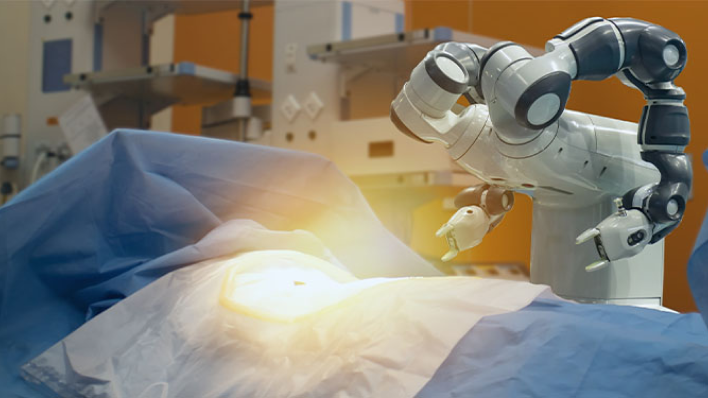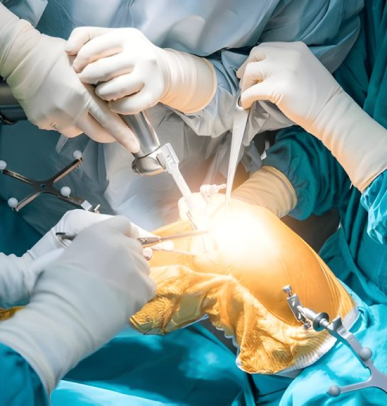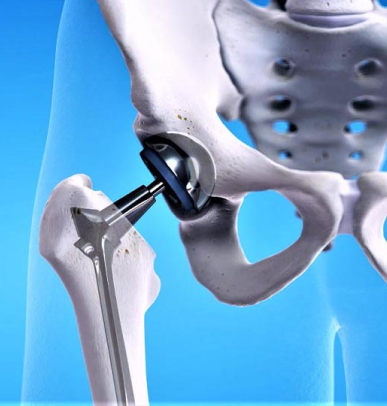Robotic Joint Replacement Surgery

Understanding
Robotic Joint Replacement Surgery Dubai
Are you suffering from chronic joint pain and looking for the most advanced solution?
At Tarabichi Joint Care, we offer robotic joint replacement surgery Dubai, a cutting-edge approach that combines the accuracy of robotic technology with the skill of our expert orthopedic surgeons.
Robotic assisted joint replacement offers a personalized surgical plan tailored to your anatomy, ensuring greater accuracy, faster recovery, and better outcomes. If you’re thinking about knee or hip replacement, robotic-assisted surgery at Tarabichi Joint Care can help you get back to doing the things you love, pain-free.
Understanding Robotic Joint Replacement Surgery
Robotic Joint Replacement Surgery is a modern surgical procedure that utilizes robotic technology to assist orthopedic surgeons in performing joint replacements with great precision.
This innovative technique is designed to reduce recovery time and improve outcomes for those suffering from joint pain due to arthritis or injury.
Common Causes for Robotic Joint Replacement Surgery
Robotic joint replacement surgery is typically recommended when conservative treatments no longer provide relief. Common causes include:
- Osteoarthritis
- Rheumatoid arthritis
- Post-Traumatic Arthritis
- Joint deformities
- Avascular necrosis
Types of Robotic Joint Replacement Surgery
At Tarabichi Joint Care, we offer different types of robotic joint reconstruction in Dubai:

Robotic Knee Replacement Dubai
Partial Knee Replacement: Replaces only the damaged knee portion, preserving healthy tissue. Ideal for patients with localized arthritis, this procedure is less invasive and offers quicker recovery. Total Knee Replacement: Replaces the entire damaged knee joint, with robotic assistance ensuring precise alignment and optimal implant positioning for better function and longevity.

Robotic Hip Replacement Dubai
Total Hip Replacement: Replaces the entire hip joint with an artificial implant. Robotic guidance ensures accurate placement within the hip socket, leading to improved outcomes.
When is Robotic Joint Replacement Surgery Recommended
- Severe joint pain or stiffness that limits everyday activities
- Moderate or severe joint pain while resting, either day or night.
- Chronic joint inflammation and swelling that does not improve with rest or medications.
- X-rays show severe joint damage or deformity.
- Non-surgical treatments like medication, physical therapy, or injections fail to relieve symptoms.
Eligible Candidates for Robotic Joint Replacement Surgery Dubai
There are no absolute age or weight restrictions for robotic joint replacement surgery. The decision to recommend surgery is primarily based on the patient’s level of pain and disability rather than age.
While most individuals undergoing total knee replacement are between 50 and 80 years old, our orthopedic surgeons assess each patient individually. Total robotic joint replacements have been successfully performed across all ages, from young teenagers to elderly patients.
How Do Robotic Joint Replacements Work
At Tarabichi Joint Care, our team of expert orthopedic doctor Dubai uses our cutting-edge robotic tools to create an ideal surgical plan, optimizing each step of your joint reconstruction in Dubai.
Before a robotic joint replacement surgery, you’ll get specialized CAT scans that create a 3-D image of your affected joint, bone structure, and surrounding tissues. This detailed picture helps our surgeon plan every step of your surgery. Cuts can be made precisely to the millimeter, picking the right implant size and positioning.
At the beginning of robotic-assisted surgery, our surgeon places tracking pins to ensure the robot has the correct size and positioning details from your CAT scans.
The robotic arm positions itself, and our surgeon uses a hand-held tool to replace your joint, enhancing precision and accuracy throughout the procedure.
Benefits of Robotic Joint Replacement Surgery Dubai
- Greater Precision: Robotic technology allows for more accurate implant positioning, leading to better alignment and improved joint function.
- Less Tissue Damage: The minimally invasive nature of the surgery results in less trauma to surrounding tissues, speeding up the recovery.
- Reduced Pain: Many patients report lower postoperative pain levels than traditional joint replacement methods.
- Enhanced Recovery: Patients benefit from early mobility and faster recovery due to minimal tissue disruption and robotic precision.
- Shorter Hospital Stay: Patients often experience shorter hospital stays and quicker returns to daily activities.
Recovery from Robotic Joint Replacement Surgery Dubai
- Weight Bearing- You may put weight on your leg immediately after surgery, depending on our doctor’s preferences and the strength of your bone. In the first few days or weeks, you might need a walker, cane, or crutches until you’re comfortable walking on your own.
- Pain Management- Feeling some pain and discomfort for a few weeks post-surgery is normal. Pain management through prescribed medications helps ensure a smoother recovery.
- Physical Therapy- Physical therapy plays a big role in getting you back on your feet after surgery. Our physical therapists will work with you on exercises to restore your joint’s range of motion and build strength.
Start Your Journey at Tarabichi Joint Care
Take the first step toward pain-free living with robotic joint replacement surgery at Tarabichi Joint Care. Our skilled orthopedic surgeons use state-of-the-art robotic technology to deliver precise, effective knee and hip replacements, ensuring quicker recovery and superior results.
Schedule your consultation today!
FAQs about Robotic Joint Replacement Surgery Dubai
During the procedure, small incisions are made around the affected joint, and an arthroscope is inserted to visualize the joint’s interior. Additional instruments may be used to repair or remove damaged tissues.
While robotic joint replacement is generally safe, potential complications may include infection, blood clots, implant failure, nerve damage, and joint stiffness.
Patients preparing for robotic joint replacement surgery typically need to provide a medical history report, recent X-rays or MRI scans, current medications, etc.
